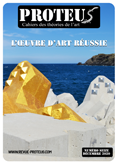Quand l’œuvre d’art épouse sa notion. Sur une hypothèse épistémologique
Abstract
 Télécharger l’article
Télécharger l’article
Paru dans : Proteus n°16

À la suite de Kant et de sa philosophie transcendantale, il est possible de déployer une pensée critique qui se propose de définir le jugement esthétique selon une approche immanente et conditionnelle des formes et des figures. La notion de parergon, déjà évoquée par Kant et approfondie par Derrida, est une première approche notable, que réengage à sa manière celle de diagramme. En effet, dès lors qu’introduit par les textes de Foucault et Deleuze, le concept de diagramme permet de poser les fondements d’un tel jugement esthétique transcendantal. Ce dernier n’est pas sans poser quelques problèmes épistémologiques, notamment en ce que tout jugement diagrammatique semble supposer un certain processus de légitimation et de justification qui devra être éclairci.
Mots-clés : Diagramme — Transcendantal — Deleuze — Foucault — Parergon
Following Kant and his transcendental philosophy, it’s possible to deploy a critical thought that proposes to define the aesthetic judgment according to an immanent and conditional approach of forms and figures. The notion of parergon, already mentioned by Kant and deepened by Derrida, is a first notable approach, reengaged in its own way the notion of diagram. Indeed, since introduced by the texts of Foucault and Deleuze, the concept of diagram allows to lay the foundations of such a transcendental aesthetic judgment. The latter is not without posing some epistemological problems, in particular in that any diagrammatic judgment seems to imply a certain process of legitimization and justification that needs to be clarified.
Keywords: Diagramm — Transcendantal — Deleuze — Foucault — Parergon








